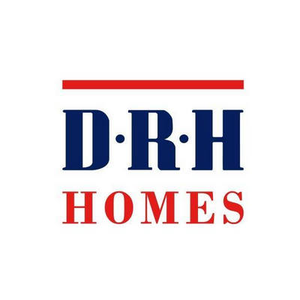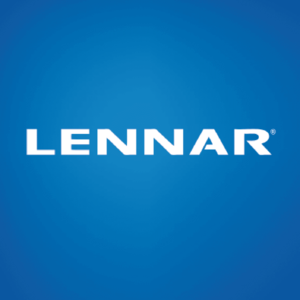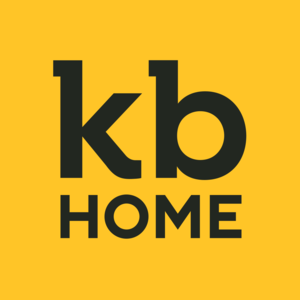
TopBuild (BLD)
TopBuild doesn’t impress us. Its low gross margin indicates weak unit economics and its recent inability to grow sales shows demand is fading.― StockStory Analyst Team
1. News
2. Summary
Why TopBuild Is Not Exciting
Established in 2015 following a spinoff from Masco Corporation, TopBuild (NYSE:BLD) is a distributor and installer of insulation and other building products.
- Absence of organic revenue growth over the past two years suggests it may have to lean into acquisitions to drive its expansion
- Gross margin of 29.9% reflects its high production costs
- On the plus side, its exciting sales outlook for the upcoming 12 months calls for 16.7% growth, an acceleration from its two-year trend


TopBuild fails to meet our quality criteria. We’d search for superior opportunities elsewhere.
Why There Are Better Opportunities Than TopBuild
High Quality
Investable
Underperform
Why There Are Better Opportunities Than TopBuild
TopBuild’s stock price of $436.97 implies a valuation ratio of 21.4x forward P/E. Yes, this valuation multiple is lower than that of other industrials peers, but we’ll remind you that you often get what you pay for.
It’s better to pay up for high-quality businesses with higher long-term earnings potential rather than to buy lower-quality stocks because they appear cheap. These challenged businesses often don’t re-rate, a phenomenon known as a “value trap”.
3. TopBuild (BLD) Research Report: Q3 CY2025 Update
Building services and installation company TopBuild (NYSE:BLD) reported Q3 CY2025 results exceeding the market’s revenue expectations, with sales up 1.4% year on year to $1.39 billion. The company expects the full year’s revenue to be around $5.4 billion, close to analysts’ estimates. Its non-GAAP profit of $5.36 per share was 1.3% above analysts’ consensus estimates.
TopBuild (BLD) Q3 CY2025 Highlights:
- Revenue: $1.39 billion vs analyst estimates of $1.38 billion (1.4% year-on-year growth, 1.2% beat)
- Adjusted EPS: $5.36 vs analyst estimates of $5.29 (1.3% beat)
- Adjusted EBITDA: $275.6 million vs analyst estimates of $272.5 million (19.8% margin, 1.1% beat)
- The company lifted its revenue guidance for the full year to $5.4 billion at the midpoint from $5.25 billion, a 2.9% increase
- EBITDA guidance for the full year is $1.04 billion at the midpoint, below analyst estimates of $1.04 billion
- Operating Margin: 15.4%, down from 17.8% in the same quarter last year
- Free Cash Flow Margin: 15.5%, similar to the same quarter last year
- Market Capitalization: $11.82 billion
Company Overview
Established in 2015 following a spinoff from Masco Corporation, TopBuild (NYSE:BLD) is a distributor and installer of insulation and other building products.
The company operates through two segments: Installation and Specialty Distribution. The Installation segment, operating under the TruTeam brand, serves a range of customers including builders, homeowners, and commercial contractors. TruTeam distinguishes itself through its nationwide network of contractor services and primarily installs fiberglass, spray foam, and cellulose insulation products.
The Specialty Distribution segment, operating under the Service Partners brand, distributes insulation, accessories, and other building materials through 160+ centers. It serves contractors, dealers, and builders, and demand is mainly driven by residential and commercial construction, remodeling, and the need for energy-efficient buildings.
The marriage of TruTeam and Service Partners makes TopBuild a one-stop-shop solution that effectively serves the broad needs of the construction industry. It also gives the company scale and a broader customer reach through local presences, providing it with competitive advantages in a fragmented market.
When expanding its business, TopBuild has been quite acquisitive. One big deal it executed was the 2021 purchase of Distribution International for $1 billion. Distribution International was a key strategic move for the company as it extended its reach into the maintenance, repair, and overhaul (MRO) market, which sports recurring revenue characteristics. This large transaction was an anomaly, however, as TopBuild generally prefers to acquire many smaller companies in the sub $50 million enterprise value range as it can negotiate better terms and pricing, giving its deals a better chance of being accretive to its earnings.
4. Home Builders
Traditionally, homebuilders have built competitive advantages with economies of scale that lead to advantaged purchasing and brand recognition among consumers. Aesthetic trends have always been important in the space, but more recently, energy efficiency and conservation are driving innovation. However, these companies are still at the whim of the macro, specifically interest rates that heavily impact new and existing home sales. In fact, homebuilders are one of the most cyclical subsectors within industrials.
TopBuild’s primary competitors include Installed Building Products (NYSE:IBP), Masco (NYSE:MAS), Owens Corning (NYSE:OC), and Builders FirstSource (NYSE:BLDR).
5. Revenue Growth
A company’s long-term sales performance is one signal of its overall quality. Any business can have short-term success, but a top-tier one grows for years. Luckily, TopBuild’s sales grew at an exceptional 14.5% compounded annual growth rate over the last five years. Its growth beat the average industrials company and shows its offerings resonate with customers.
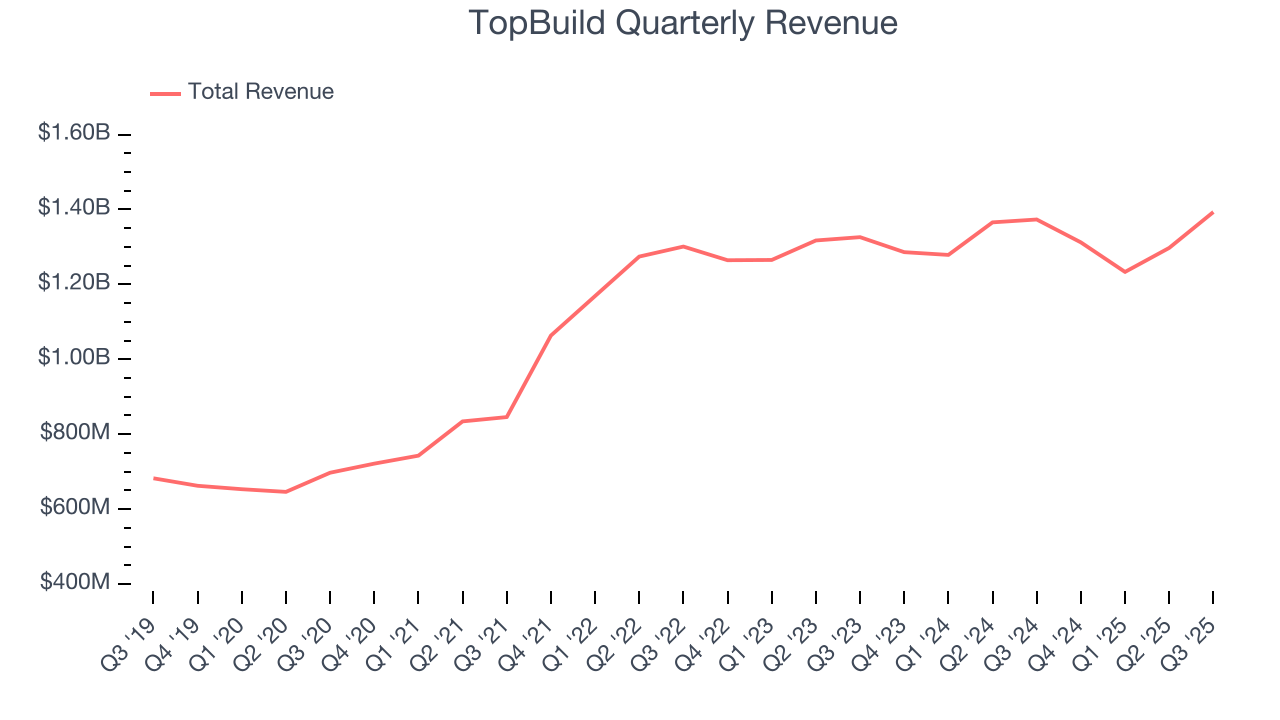
Long-term growth is the most important, but within industrials, a half-decade historical view may miss new industry trends or demand cycles. TopBuild’s recent performance shows its demand has slowed significantly as its revenue was flat over the last two years. 
This quarter, TopBuild reported modest year-on-year revenue growth of 1.4% but beat Wall Street’s estimates by 1.2%.
Looking ahead, sell-side analysts expect revenue to grow 13.5% over the next 12 months, an improvement versus the last two years. This projection is admirable and suggests its newer products and services will fuel better top-line performance.
6. Gross Margin & Pricing Power
Gross profit margin is a critical metric to track because it sheds light on its pricing power, complexity of products, and ability to procure raw materials, equipment, and labor.
TopBuild’s gross margin is slightly below the average industrials company, giving it less room to invest in areas such as research and development. As you can see below, it averaged a 29.9% gross margin over the last five years. Said differently, TopBuild had to pay a chunky $70.15 to its suppliers for every $100 in revenue. 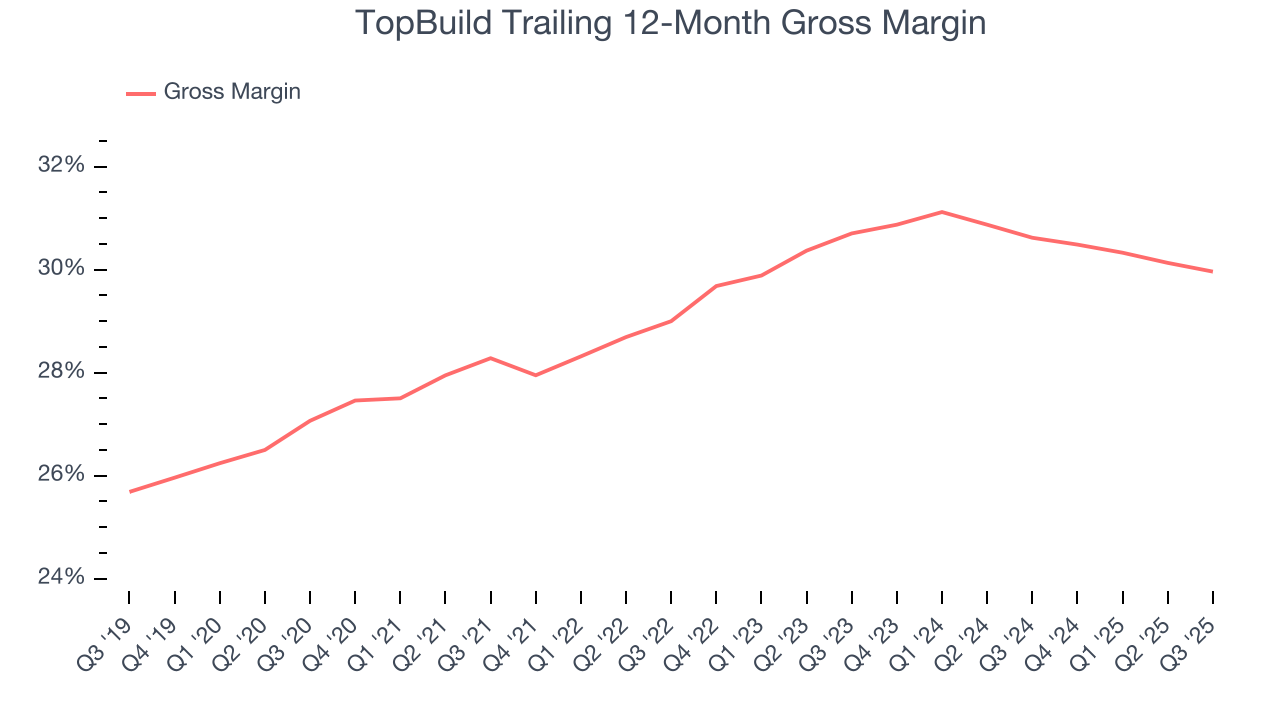
In Q3, TopBuild produced a 30.1% gross profit margin, in line with the same quarter last year. Zooming out, the company’s full-year margin has remained steady over the past 12 months, suggesting its input costs (such as raw materials and manufacturing expenses) have been stable and it isn’t under pressure to lower prices.
7. Operating Margin
TopBuild has been a well-oiled machine over the last five years. It demonstrated elite profitability for an industrials business, boasting an average operating margin of 15.9%. This result was particularly impressive because of its low gross margin, which is mostly a factor of what it sells and takes huge shifts to move meaningfully. Companies have more control over their operating margins, and it’s a show of well-managed operations if they’re high when gross margins are low.
Analyzing the trend in its profitability, TopBuild’s operating margin rose by 1.2 percentage points over the last five years, as its sales growth gave it operating leverage. Its expansion was impressive, especially when considering most Home Builders peers saw their margins plummet.
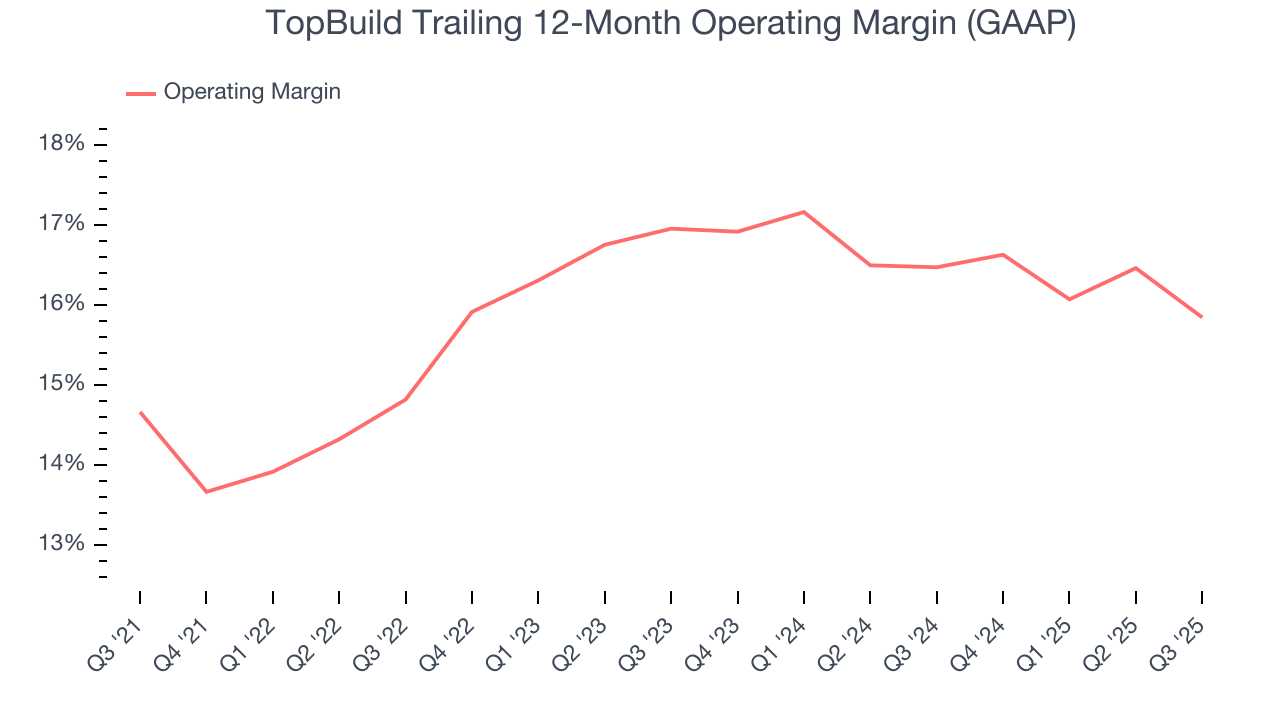
In Q3, TopBuild generated an operating margin profit margin of 15.4%, down 2.3 percentage points year on year. Since TopBuild’s operating margin decreased more than its gross margin, we can assume it was less efficient because expenses such as marketing, R&D, and administrative overhead increased.
8. Earnings Per Share
Revenue trends explain a company’s historical growth, but the long-term change in earnings per share (EPS) points to the profitability of that growth – for example, a company could inflate its sales through excessive spending on advertising and promotions.
TopBuild’s EPS grew at an astounding 25.2% compounded annual growth rate over the last five years, higher than its 14.5% annualized revenue growth. This tells us the company became more profitable on a per-share basis as it expanded.
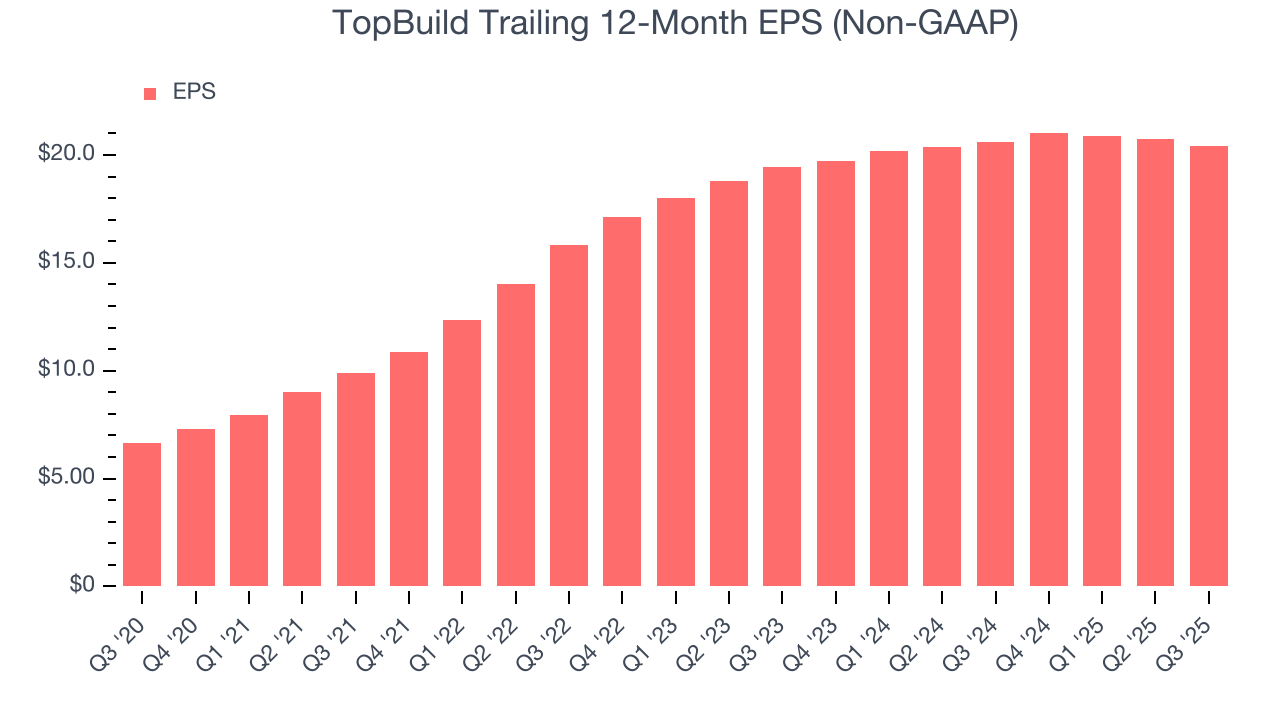
Diving into the nuances of TopBuild’s earnings can give us a better understanding of its performance. As we mentioned earlier, TopBuild’s operating margin declined this quarter but expanded by 1.2 percentage points over the last five years. Its share count also shrank by 15.1%, and these factors together are positive signs for shareholders because improving profitability and share buybacks turbocharge EPS growth relative to revenue growth. 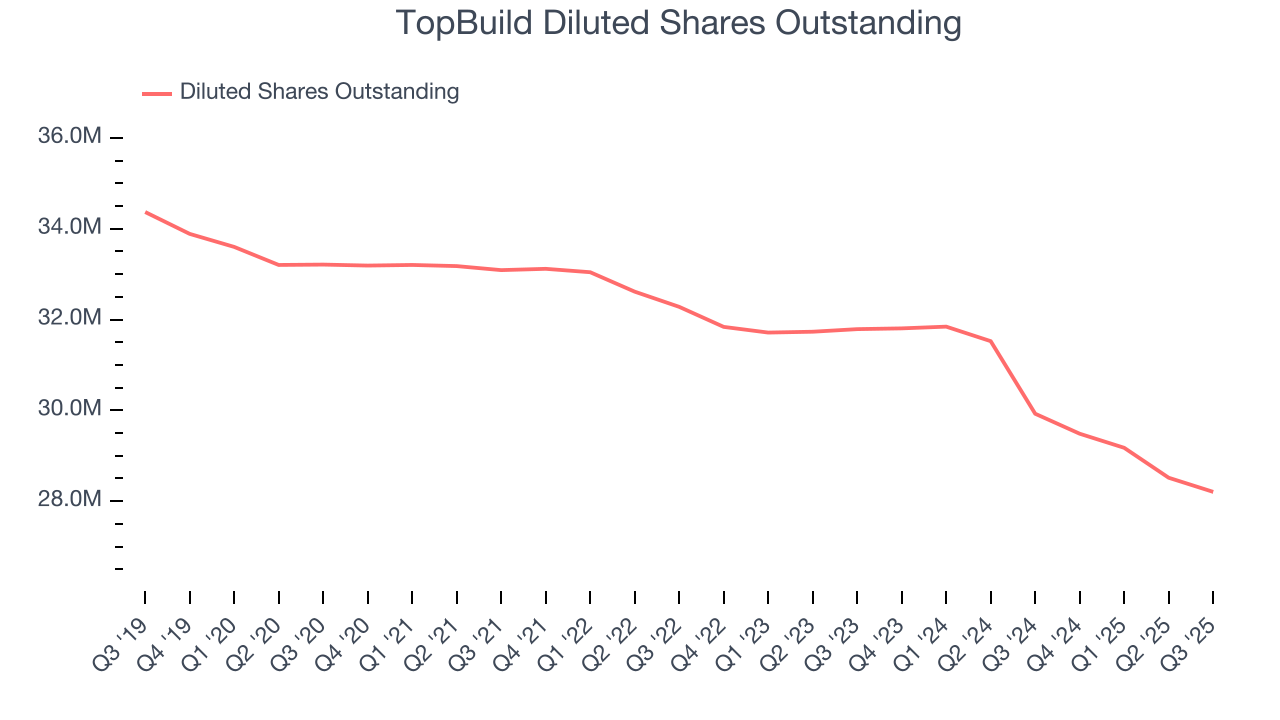
Like with revenue, we analyze EPS over a shorter period to see if we are missing a change in the business.
For TopBuild, its two-year annual EPS growth of 2.5% was lower than its five-year trend. We hope its growth can accelerate in the future.
In Q3, TopBuild reported adjusted EPS of $5.36, down from $5.68 in the same quarter last year. Despite falling year on year, this print beat analysts’ estimates by 1.3%. Over the next 12 months, Wall Street expects TopBuild’s full-year EPS of $20.43 to grow 6.2%.
9. Cash Is King
If you’ve followed StockStory for a while, you know we emphasize free cash flow. Why, you ask? We believe that in the end, cash is king, and you can’t use accounting profits to pay the bills.
TopBuild has shown robust cash profitability, enabling it to comfortably ride out cyclical downturns while investing in plenty of new offerings and returning capital to investors. The company’s free cash flow margin averaged 12.2% over the last five years, quite impressive for an industrials business.
Taking a step back, we can see that TopBuild’s margin expanded by 3.8 percentage points during that time. This shows the company is heading in the right direction, and we can see it became a less capital-intensive business because its free cash flow profitability rose more than its operating profitability.
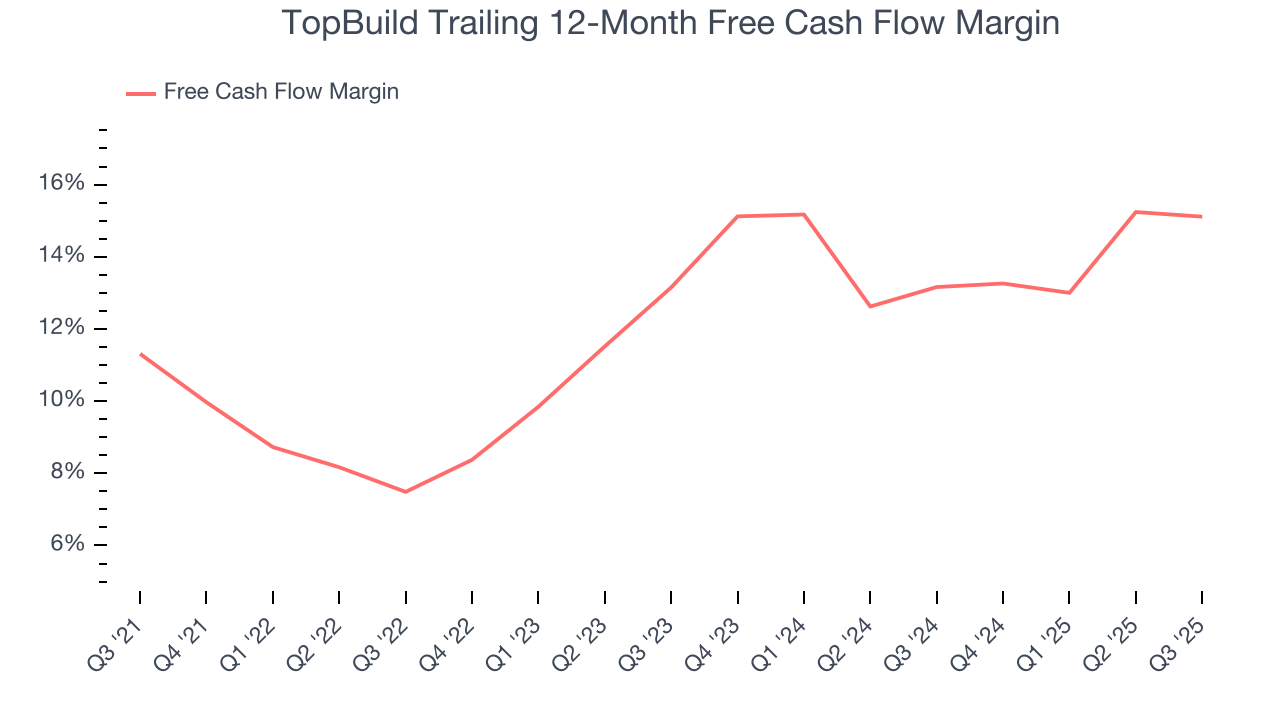
TopBuild’s free cash flow clocked in at $216.2 million in Q3, equivalent to a 15.5% margin. This cash profitability was in line with the comparable period last year and above its five-year average.
10. Return on Invested Capital (ROIC)
EPS and free cash flow tell us whether a company was profitable while growing its revenue. But was it capital-efficient? A company’s ROIC explains this by showing how much operating profit it makes compared to the money it has raised (debt and equity).
Although TopBuild hasn’t been the highest-quality company lately, it found a few growth initiatives in the past that worked out wonderfully. Its five-year average ROIC was 19.5%, splendid for an industrials business.
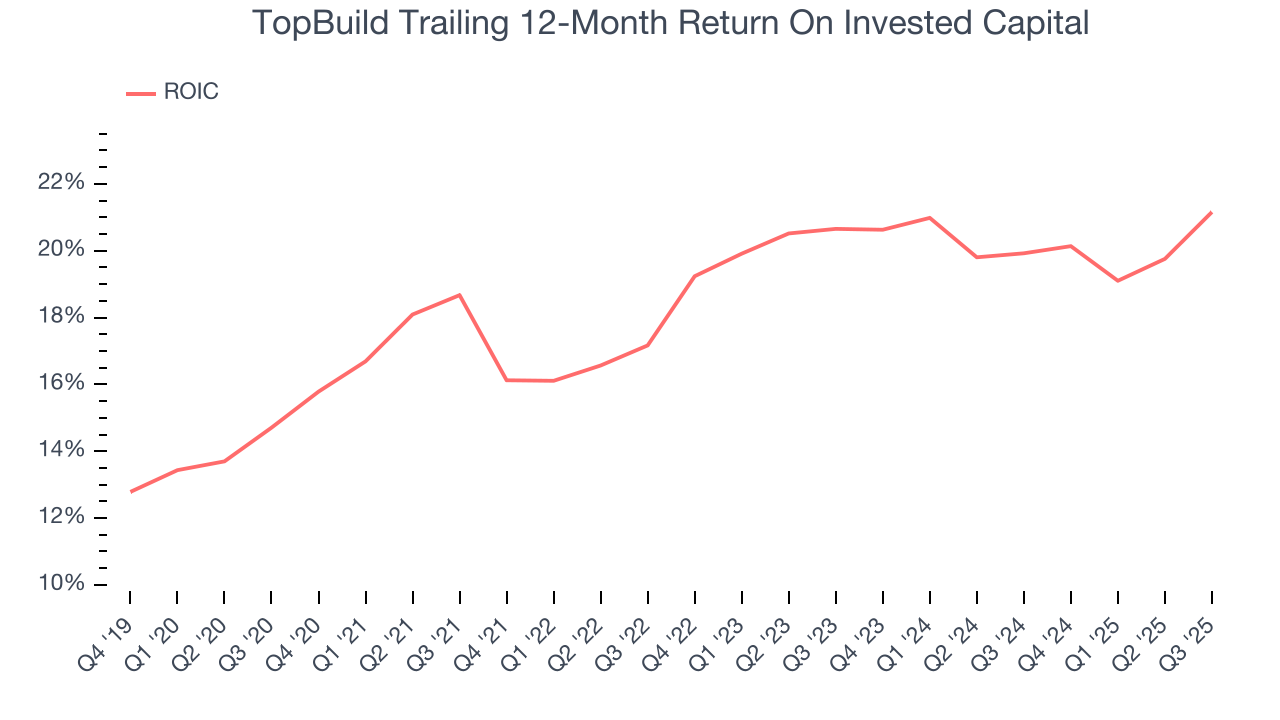
We like to invest in businesses with high returns, but the trend in a company’s ROIC is what often surprises the market and moves the stock price. Over the last few years, TopBuild’s ROIC averaged 2.6 percentage point increases each year. This is a good sign, and if its returns keep rising, there’s a chance it could evolve into an investable business.
11. Balance Sheet Assessment
TopBuild reported $1.14 billion of cash and $3.09 billion of debt on its balance sheet in the most recent quarter. As investors in high-quality companies, we primarily focus on two things: 1) that a company’s debt level isn’t too high and 2) that its interest payments are not excessively burdening the business.
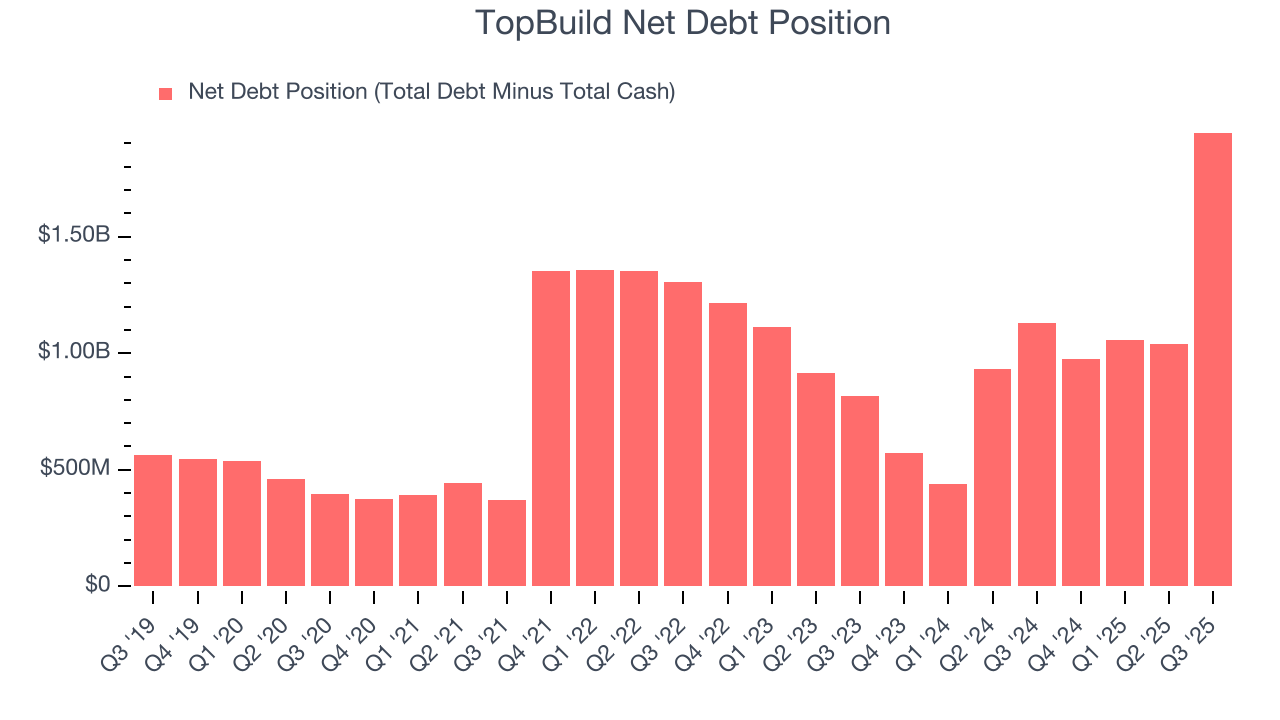
With $1.03 billion of EBITDA over the last 12 months, we view TopBuild’s 1.9× net-debt-to-EBITDA ratio as safe. We also see its $26.01 million of annual interest expenses as appropriate. The company’s profits give it plenty of breathing room, allowing it to continue investing in growth initiatives.
12. Key Takeaways from TopBuild’s Q3 Results
It was good to see TopBuild narrowly top analysts’ revenue expectations this quarter. We were also happy its EBITDA narrowly outperformed Wall Street’s estimates. On the other hand, its full-year EBITDA guidance slightly missed. Zooming out, we think this was a mixed quarter. The stock remained flat at $421.01 immediately following the results.
13. Is Now The Time To Buy TopBuild?
Updated: December 5, 2025 at 10:58 PM EST
Before investing in or passing on TopBuild, we urge you to understand the company’s business quality (or lack thereof), valuation, and the latest quarterly results - in that order.
TopBuild has a few positive attributes, but it doesn’t top our wishlist. First off, its revenue growth was exceptional over the last five years and is expected to accelerate over the next 12 months. And while TopBuild’s organic revenue declined, its astounding EPS growth over the last five years shows its profits are trickling down to shareholders.
TopBuild’s P/E ratio based on the next 12 months is 21.4x. While this valuation is reasonable, we don’t really see a big opportunity at the moment. We're fairly confident there are better stocks to buy right now.
Wall Street analysts have a consensus one-year price target of $480.93 on the company (compared to the current share price of $436.97).





